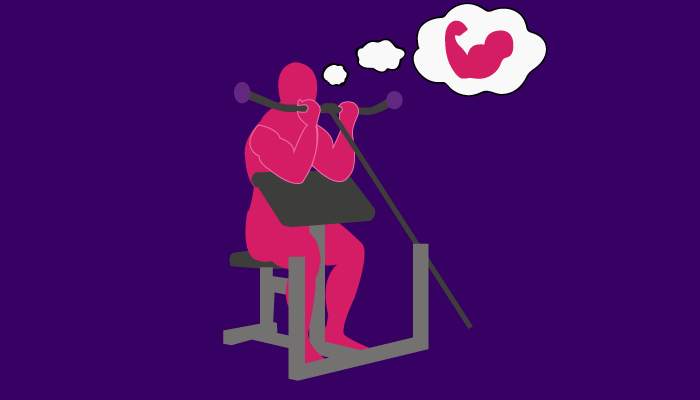
Many bodybuilders have advocated the use of the mind-muscle connection for maximizing muscle growth.
But, what does the current evidence say?
Does the mind-muscle connection help build more muscle?
“I think the biggest mistake is that you go to the gym, and you go through the motion, but you don’t really have your mind inside the muscle” – Arnold Schwarzenegger
Table of Contents
What Is the Mind-Muscle Connection?
The mind-muscle connection is aiming to squeeze and maximally activate a particular muscle during an exercise.
For instance, during a standing barbell biceps curl, applying a mind-muscle connection would mean you squeeze the biceps muscle as much as you possibly can, with the intent of maximizing its activation throughout the whole duration of the exercise.
So, can utilizing this technique in your training help build more muscle?
Electromyographic Data
When a muscle contracts, it does so because of the electrical signals it receives from the nervous system. Electromyography (EMG) measures the extent of these electrical signals received by a muscle.
Quite a few studies have attempted to use EMG to determine whether using the mind-muscle connection during an exercise could increase a muscle’s electrical activity.
Some papers have found that the mind-muscle connection can indeed result in greater electrical muscle activity of a targeted muscle.
For example, Snyder et al. found that during a 50% one-rep max bench press, focusing exclusively on using the chest muscles resulted in a 22% increase in chest electrical activity compared to not using this technique. Additionally, aiming to focus on using the triceps during this 50% one-rep max bench press increased its electrical activity by 25.7% compared to not using this technique.
Similarly, Calatayud et al. found that focusing on the chest muscles during bench presses with loads ranging from 20 to 60% one-rep max resulted in greater electrical activity of this muscle compared to not using this technique. The same results also applied to the triceps.
Another paper by Snyder et al. found that latissumus dorsi electrical activity increased by 17.6% when subjects focused on this muscle during lat pulldowns.
However, there is also evidence that the mind-muscle connection has no impact on the electrical activity of a muscle.
Paoli et al. found that although focusing on the triceps did increase its activation during 50% and 80% one-rep max bench presses, focusing on the chest muscles did not increase its electrical activity (these results conflict with the Snyder et al. paper).
Fujita et al. found that during a 70% one-rep max seated row, aiming to pull with the back did not increase the electrical activity of the latissumus dorsi or teres major.
So, the results are a little mixed here. Nevertheless, with all this said, although electromyography does generally measure a muscle’s electrical activity, it’s not without its limitations. Moreover, there are noteworthy complications when inferring long term outcomes (such as muscle growth) from EMG data exclusively.
In other words, studies that directly measure muscle growth before and after a training period are substantially more reliable than EMG research.
Fortunately, there are two studies of this type that can give us a greater insight into whether the use of the mind-muscle connection can enhance muscle hypertrophy.
Direct Research
This first study by Counts et al. technically did not aim to determine if the mind-muscle connection helped build more muscle, rather it gives us a fascinating insight into whether squeezing and maximally contracting a muscle produces hypertrophy (the basis of the mind-muscle connection).
Protocol:
13 untrained individuals (5 men, 8 women) had one arm assigned to a no-load condition and their other arm assigned to a high load condition.
Participants trained both their arms three times per week for 6 weeks.
With the arm that was assigned to the no-load condition, they performed a biceps curl with no actual weight, but they aimed to squeeze and maximally contract the biceps throughout the curling movement. They did this for 4 sets of 20 reps with 30 seconds of rest between sets.
With the opposite arm assigned to the high load condition, they performed a dumbbell biceps curl with 70% of their one-rep max. They did this for 4 sets of 8-12 reps with 90 seconds of rest between sets.
Measurements:
Thickness of the biceps muscle was measured at three regions, roughly 50, 60, and 70% of the upper arm length.
Results:

At all three regions of the biceps, increases in thickness were similar between the two conditions.
In other words, biceps curls with no load, but trying to squeeze and maximally activate the biceps throughout the curling motion resulted in similar gains to regular dumbbell curls.
These results are remarkably interesting, I’m sure not many would have expected that no-load biceps curls can produce similar gains to dumbbell biceps curls.
As mentioned before detailing this study, this study didn’t explicitly test the mind-muscle connection. But what this study does suggest, is that squeezing and aiming to maximally activate a muscle (which is the basis of the mind-muscle connection) may indeed result in significant growth.
The question now becomes whether aiming to do this during a loaded exercise can help build more muscle.
This is where a great paper by Schoenfeld et al. comes in. This research paper is the only paper currently that has directly tested the mind-muscle connection for growth.
Protocol:
27 untrained men were split into an internal focus group or an external focus group.
Both groups trained the standing biceps curl and leg extension for 4 sets of 8-12 reps (each set taken to failure), three times per week for 10 weeks.
On each rep, the internal focus group was told to focus on squeezing the targeted muscle (the biceps for the standing biceps curl and the quadriceps for the leg extension). So this was the mind-muscle connection group.
The external focus group was told to focus on getting the weight up on each rep for both exercises.
Measurements:
Thickness of the elbow flexors (which would have included the biceps and brachialis), rectus femoris, and vastus lateralis were measured before and after the 10 weeks for both groups.
Results:

The internal focus group (the mind-muscle connection group) experienced significantly greater increases in elbow flexor thickness compared to the external focus group.
But increases in thickness for the rectus femoris and vastus lateralis were similar between both groups.
So, the mind-muscle connection did seem to help build more muscle for the elbow flexors, but not for the quadriceps (rectus femoris and vastus lateralis).
This is intriguing, why might the mind-muscle connection not benefit the quadriceps?
Unfortunately, the researchers did not attempt to measure any mechanistic reasons as to why this was.
But they did provide some very interesting insight. They stated that several participants found it easier to focus on the biceps compared to the quadriceps.
In normal life, the upper body is typically involved in finer motor tasks (such as writing), whereas the lower body is primarily involved in larger tasks (such as walking). This could explain why individuals are better able to control and focus on their biceps, but not their quadriceps.
With training experience (remember, the participants in this study were untrained), developing a mind-muscle connection with the quadriceps may be possible. This, in turn, may be able to result in greater growth.
Of course, this is speculative, and future research would be required to validate this idea.
Before moving on, if you’re curious about creating an effective training program for muscle hypertrophy, our high quality partner Alpha Progression can help. It can generate a highly effective program for you, track your workouts live with in-built progression recommendations, provide graphs displaying your long term progress, and it has a massive exercise database with more than 550 exercises.
Click HERE (the link opens in a new tab) to get a free 2 week trial of the apps features. If you like it and go beyond, the link also gives you 20% off a subscription!
We never promote trash at the House of Hypertrophy, so rest assured the app is high quality. The reviews speak to this, 4.8 starts (based on more than 7,000 reviews) on Google play, and 4.9 stars in Apple’s store (based on nearly 400 ratings).
Further Discussion
From the Counts et al. study, but mainly the Schoenfeld study, there is evidence that the mind-muscle connection can help build more muscle.
But it’s also important to consider these results in the context of the study.
Both of these studies used single-joint exercises (isolation exercises). Single-joint exercises may be the most practical and easiest type of movement to apply the mind-muscle connection too.
Additionally, most people employ moderate rep ranges (as the Counts and Schoenfeld study did) or higher reps ranges with single-joint exercises. The use of these slightly light loads is probably favorable for applying the mind-muscle connection.
This all said, the mind-muscle connection could still work with multi-joint exercises, probably with the use of moderate or higher rep ranges.
Returning to the electromyographic data presented near the start of this article, the mind-muscle connection was able to increase the electrical activity of a targeted muscle in multi-joint exercises with lighter loads.
One study that did not find a benefit to the mind-muscle connection was a study by Fujita et al., and they used a somewhat heavy-ish load of 70% one-rep max.
Also, as mentioned already, the Calatayud et al. study did find that the mind-muscle connection increased electrical activity of the chest and triceps during bench presses with loads ranging from 20% to 60% one-rep max. But what I didn’t mention was they also tested out the mind-muscle connection for the chest and triceps at an 80% one-rep max bench press. At this load, neither the chest or triceps experienced greater electrical activity with the mind-muscle connection.
Now of course, considering the limitations with EMG is important, but regardless, I feel these results nicely express what most people may find intuitive and apparent.
With heavier loads, it would simply be more difficult to focus on a particular muscle, as much of your attention would be directed towards just moving the load, as after all, the load is heavy.
So, lighter loads are likely better for using the mind-muscle connection.
Another important thing worth mentioning here is that given lighter loads are likely better for using the mind-muscle connection, strength development will likely be less.
Although many people of course want to build substantial muscle, many people do as well want to be strong on some exercises, mainly multi-joint exercises.
For example, having a strong bench press, squat, or deadlift is a goal for many people. If this applies to you, it’s probably best to avoid trying to use the mind-muscle connection on these movements for the most part, and rather just focus on using relatively heavier loads.
Conclusions
- With single-joint upper body exercises, such as biceps curls, there is direct evidence that using the mind-muscle connection can help build more muscle.
- With single-joint lower body exercises, you may wish to try and develop a mind-muscle connection with your lower body, this may help build more muscle.
- With upper and lower multi-joint exercises, the mind-muscle connection could work with lighter loads, so you may wish to experiment with this. But also note that strength gains will likely suffer if you do this, but if your goal is only to maximize muscle hypertrophy, this would be fine.
Remember to feel free to check out the Alpha Progression App if you’re interested. Also feel free to check out our free bench press e-book below.

